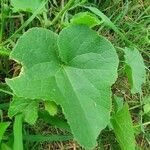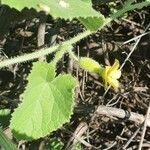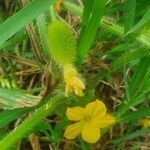Vines; stems hispid. Leaves suborbicular to reniform, 5-10 cm long, as broad or broader than long, slightly 3-to 5-angulate, the base cordate, the apex of the lobes rounded, the margin dentate, membranaceous or chartaceous, both surfaces hispid or scabrous; petiole 5-12 cm long, hispid. Staminate flowers axillary, soli-tary or fasciculate; peduncle 0.5-2.0 cm long; calyx subcylindrical, the lobes ca. 2 mm long, subulate, hirsute, green; corolla campanulate, the lobes 6-8 mm long, yellow, oblong, the apex acute, spreading; stamens ca. 3-4 mm long, the anthers 2-3 mm long, the appendix of connective dilated, bilobate, ca. 1 mm long, the apex ciliate; pistillodium glandlike. Pistillate flowers solitary in the same axils as staminate flowers; peduncles 1-2 cm long; calyx and corolla as in the staminate flowers; ovary oblong, densely hispid; style 1-2 mm long; stigma forming a spherical head. Fruit pale yellow, ovoid cylindrical 3-8 cm long, 2-5 cm in diameter, densely spiny; seeds pale brown, oblong, compressed, 4.0-5.0 mm long, 2 mm wide.
A pumpkin family herb. It is an annual plant growing each year from seed. It grows 50 cm high and spreads 2 m wide. The stems are slender and trailing. They have prickles. It has tendrils. The leaves are oval to kidney shaped. They can be 10 cm long. The flowers are funnel shaped and yellow. The fruit are hairy oval berries. They are yellow and 3-7 cm long by 3-4 cm wide.
A slender annual climber with pale green stem.









